The Ultimate Guitar Gear Guide for Beginners (2025 Edition)
“Alright, I’m going to learn how to play the guitar!”
Just like my favorite artists, I’m going to play that song I love!
That burning passion you’re feeling is your passport to a whole new world.
But at the same time, are these anxieties creeping into your mind?
“Where do I even start…?”
“There are so many types of guitars, I have no idea which one is right for me…”
“Honestly, all this technical jargon is Greek to me…”
I’m sure many of you feel this way, right?
Don’t worry. This article will solve every single one of those problems.
Nice to meet you! My name is Shohei Takamura, and I run a guitar school called “Guitar Prescription TAKAMURA” in Fujisawa, Kanagawa.
I’ve taught over 400 students, some of whom have become professional guitarists. I’ve also worked as a seminar instructor for audio equipment manufacturers and have been involved in the sound creation for numerous major artists. In that time, I have handled literally hundreds, if not thousands, of guitars and pieces of gear.
Drawing on that professional perspective, and more importantly, my passionate desire to ensure that you, the beginner, absolutely do not give up, I will explain *everything* you need to know to choose your gear without regret, more clearly and deeply than anywhere else.
Let’s put an end to being misled by beginner set advertisements and fragmented information.
By the time you finish this article, you will have the solid knowledge and confidence to find “your own perfect partner.”
Chapter 1: The Bottom Line – Your 7 Essential Items
Learning guitar is like building a house.
You don’t start by putting up pillars or adding the roof, right? (Haha)
First, you build a solid foundation, which ensures the house will be safe and sound later on.
Choosing gear is the same. Let’s start by understanding the minimum necessary items that will form the “foundation” of your life as a guitarist. Don’t worry, we’ll cover how to choose each one in detail in the later chapters.
- Electric Guitar: The star of the show. The “main body,” which will become an extension of yourself.
- Guitar Amp: The heart that produces the electric guitar’s sound. The amp is just as much a part of you as the guitar.
- Tuner: The “tuner” that gets you to the correct pitch.
- Picks: An important element for striking the strings. They have a major impact on your tone.
- Instrument Cable: The vital link between your guitar and amp. It significantly affects sound quality.
- Guitar Strap: Essential if you plan to play standing up. It also greatly changes your stage presence.
- Guitar Stand: A designated spot to safely store your beloved instrument. A wobbly stand can be fatal.
These seven items are the ultimate starting lineup to get you on the field.
Chapter 2: The Most Important Step – How to Choose Your Guitar
Alright, this is the core of it all. Choosing a guitar is the first and biggest hurdle. But if you understand this part correctly, the fun will accelerate instantly. I’ll prescribe all the knowledge you need to avoid regret, based on my experience with countless students.
2-1. The Eternal Debate: Acoustic vs. Electric for Beginners?
The short answer is: the right choice is “the one used in the music you want to play or by the artists you admire.” However, knowing the characteristics of each will make your choice a more confident one.
| Feature | Acoustic Guitar | Electric Guitar |
|---|---|---|
| Sound | Warm, natural tone. No power needed. | Can be anything from clean to distorted, depending on the amp. |
| Playability | Strings are thicker and stiffer, requiring more finger strength. | Strings are thinner and softer. Can be pressed with less force. |
| Practice Environment | Volume is hard to control, making nighttime practice difficult. | With headphones, you can practice anytime. |
| Frustration Point | Sore fingers, “the F chord wall” can be a major hurdle. | More gear and things to learn at the beginning. |
From my experience with many beginners, I feel that the “ease of pressing strings” and “ease of volume control” of an electric guitar are huge advantages in preventing frustration. Less finger pain means you can focus on practicing, and using headphones means you can get lost in it without worrying about the time.
2-2. Understanding Electric Guitar Shapes and Personalities
Electric guitars come in various shapes, each with its own strengths and personality. Let’s understand the three main types by comparing them to human characters.
① Stratocaster Type: The Talented, Well-Rounded All-Star
With a contoured body that fits comfortably, it offers a wide range of sounds. It excels at sharp, sparkling tones. Its versatility makes it great for rock, pop, and blues. It’s the king of guitars—when in doubt, choose this one.Find on Amazon
② Telecaster Type: The Quirky but Straightforward Individualist
A simple design with a twangy, direct sound. It can’t do everything, but it has an integrity that sticks to its guns. Seeing a singer-songwriter strumming one while singing is just plain cool.Find on Amazon
③ Les Paul Type: The Passionate Rocker with a Fat, Sweet Voice
A bit heavier than the others, but in return, it produces a thick, sweet, and powerful sound. Its singing sustain is synonymous with rock music. If you want to play passionate guitar solos, this will be your best friend.Find on Amazon
2-3. Pickups Define the Sound! (Crucial Info)
Pickups are the “microphones” of the guitar that convert string vibrations into electrical signals. Their differences determine the guitar’s “vocal quality.” There are two main types.
- Single-Coil: A sharp, delicate voice. Perfect for the bright rhythm parts in pop and funk. Its one weakness is that it can be a bit noisy. Common on Strats and Teles.
- Humbucker: A powerful, thick voice. Ideal for the heavy riffs of hard rock. It’s less noisy and doesn’t get muddy even with heavy distortion. Common on Les Pauls.
Again, it’s not about which is “better,” but “what kind of music you want to play.” Researching which type your favorite artists use can be very helpful.
2-4. A Pro’s 5-Point Checklist for a No-Regret Purchase
Now for the specific “prescription.” As someone who has seen countless guitars, here are the five points I insist every beginner check.
The 5-Point No-Regret Checklist
- 1. The Look (Most Important!): If you’re torn on performance, always choose the one you’ve fallen in love with visually. Whether you think “Wow, this is cool…” when you take it out of the case makes a world of difference to your motivation. I can guarantee this.
- 2. The Budget (Be Realistic!): Aim for a price range of $300 to $700. This range is full of reliable models from subsidiaries of famous brands, offering the best balance of quality, sound, and playability. It’s wise to avoid the sub-$200 “beginner packs,” as they often lead to frustration.
- 3. The Feel (Check if Possible!): If you can get to a music store, actually hold the guitar. How does the neck feel in your hand? How heavy is it when you stand up? You can’t get this “physical feedback” from a spec sheet.
- 4. Your Favorite Artist (Inspiration is Rocket Fuel!): What kind of guitar does your favorite guitarist play? Inspiration is the most powerful fuel for improvement. Just owning the same type of guitar will make practicing more fun.
- 5. New vs. Used (Beginners, Always Go New!): Used guitars can be cheaper, but it’s nearly impossible for a beginner to judge their condition. Start with a new guitar that comes with a manufacturer’s warranty for peace of mind.
2-5. [2025 Edition] Takamura’s Top Guitar Brands & Models for Beginners
“I get the theory, but which specific ones are good?” To answer that, I’ve selected brands and models that I can confidently recommend. You can’t go wrong with these.
- Squier by Fender: The official subsidiary of the king of guitars, “Fender.” Get that classic sound at an affordable price.Find on Amazon
- Epiphone: The official subsidiary of the other giant, “Gibson.” The choice for a rock-oriented sound.Find on Amazon
- YAMAHA: A world-renowned Japanese instrument maker. Top-notch build quality and playability. The “PACIFICA” series is legendary.Find on Amazon
- Ibanez: Known for thin necks that are great for technical playing. Also a good choice for players with smaller hands.Find on Amazon
- Bacchus: A popular Japanese brand known for its excellent cost-performance. Their wide range of colors is also a plus.Find on Amazon
▼ Look for guitars like the ones introduced here ▼
Chapter 3: The Heart of Your Sound – How to Choose a Guitar Amp
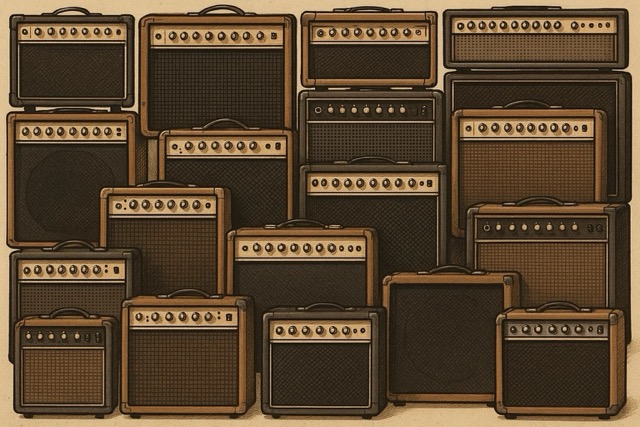
An electric guitar only shows its true potential when plugged into an amp. If you choose a great guitar but a mediocre amp, it’s a waste. It’s like cooking A5-grade Wagyu beef on a weak stove. (Haha)
For beginners practicing at home, there’s one clear choice: a “modeling amp.”
This is a high-tech amp that uses digital technology to recreate the sounds of famous amps and effects from around the world in a single unit. With one of these, you can experience everything from clean tones to heavy distortion.
3-Point Checklist for a Home Practice Amp
- Output (Wattage): For home use, 5W to 15W is more than enough. Higher wattage isn’t always better.
- Features (Headphone Jack and AUX In): These two are absolute must-haves. A headphone jack lets you practice at night, and an AUX In jack lets you play along with your favorite songs.
- Connectivity (USB or Bluetooth): Modern models let you connect to a PC for recording or shape your tone with a smartphone app, making it as fun as a video game. The Bluetooth feature, which lets you stream audio wirelessly from your phone, is especially convenient.
[2025 Edition] Takamura’s Top Amp Models for Beginners
Let me give you some specific models. These are the three I confidently recommend to my own students. (Read the detailed article here)
- YAMAHA THR-II Series: The amp that started the “desktop amp” trend. High-quality sound and a fantastic design. It’s like a piece of high-end audio equipment.Find on Amazon
- BOSS KATANA Series: From the king of effects pedals, BOSS. Features practical, great-sounding rock tones. Very intuitive to use.Find on Amazon
- Positive Grid Spark Series: The dedicated app is incredible. It has innovative features that make practice fun, like “auto-display chords for any song” and “auto-generate a backing track for your riff.” It’s like having a ChatGPT practice buddy!Find on Amazon
Chapter 4: Essential Accessories – The Small but Crucial Supporting Cast
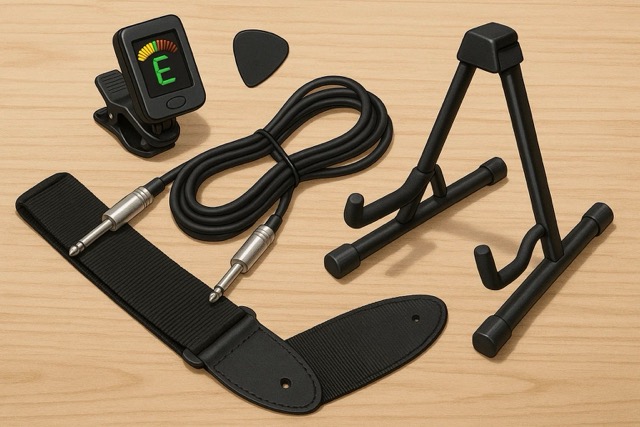
Once you’ve chosen your main characters—the guitar and amp—it’s time for the supporting cast. They may seem minor, but you can’t start practicing without them.
- Tuner: A “clip-on tuner” that attaches to the headstock is easy and accurate. For about $10-$20, you get the foundation for developing a good sense of pitch.(Read the detailed article here)
- Picks: The shape and thickness change the sound surprisingly. Start with a variety pack (around $5) to embark on a journey of finding your favorite.(Read the detailed article here)
- Instrument Cable: A length of 10 feet (3 meters) is standard for home practice. Choose a reliable brand in the $15-$30 range. Cheap cables can cause noise and break easily.
- Guitar Strap: This one you can choose by design! Pick a favorite that matches your guitar and get pumped up.(How to choose a strap)
- Guitar Stand: Leaning your guitar against a wall is a huge no-no! To prevent the tragedy of your beloved instrument falling and breaking its neck, you must get one. Having it on display in your room will also make you want to pick it up and play more often.(Read the detailed article here)
Chapter 5: “Nice-to-Have” Items – Making Practice More Fun
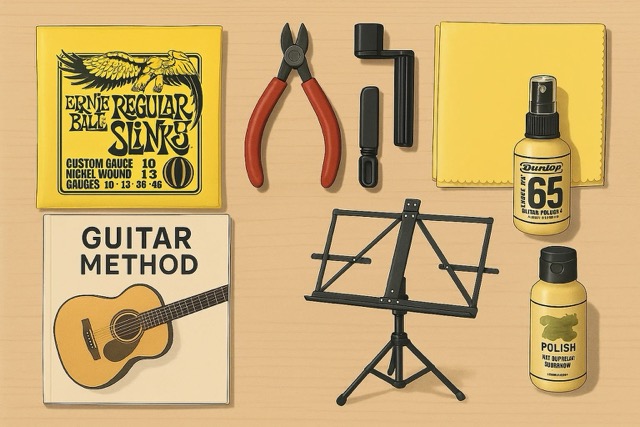
These aren’t essential from day one, but they’re items you’ll definitely want later on.
Useful Gadgets for Leveling Up
- Spare Strings: Strings are consumables. It’s good to have a backup set.
- String-Changing Tools: A string winder and cutters make the tedious job of changing strings much easier.
- Instructional Books/Videos: YouTube is great, but a well-structured book can help organize your knowledge.
- Music Stand: Essential for practicing with good posture.
- Maintenance Supplies: A polishing cloth and cleaner. Tools to keep your beloved instrument in great shape for a long time.
Chapter 6: Where to Buy? The Pros and Cons of Each Option
Once you know what gear you want, the final question is where to buy it. The main options are a “music store” and “online.”
Let me give you the bottom line: For beginners, I strongly, strongly recommend visiting a music store in person at least once.
Why? The biggest advantage is that you can “try before you buy.” Actually touching the guitar, hearing it, and feeling its weight. This “real-life information” is more valuable than reading 100 online reviews.
Plus, the expert staff at a music store are like “guitar sommeliers.” They can suggest the perfect instrument based on the music you want to play and your budget.
Of course, the low prices and wide selection of online stores are also appealing. Therefore, the ideal approach might be a hybrid: “First, go to a music store to see and touch the real thing and talk to the staff. Then, compare prices online and make your final, confident decision.”
Chapter 7: Frequently Asked Questions (FAQ)
Finally, I’ll answer some of the questions I’ve been asked countless times by my students.
Should I buy one of those cheap “beginner sets”?
I understand the appeal, but I don’t recommend it. The gear in those sets is often of the lowest quality, goes out of tune easily, and sounds bad, which often leads to the conclusion “guitar is boring” and causes people to quit. You will have a much better and longer-lasting experience if you spend a little more to get the reliable, individual items mentioned in this article.
Can I learn on my own? Can I become a pro?
Yes, you can learn to play on your own. There are plenty of high-quality free resources available today. However, if you want to become a pro or improve as quickly as possible, getting proper instruction is the fastest path. When you build a house, you don’t start without a blueprint, right? It’s the same principle. Having someone to give you the right “blueprint” (= practice methods) and help with the “foundation” will dramatically change the speed and quality of your progress.
I’m left-handed. What should I do?
Don’t worry, there are left-handed guitars (lefty models) available. However, the selection is usually smaller than for right-handed models. Some lefties choose to learn on a right-handed guitar, but this has its pros and cons. The best thing to do is go to a store and hold both to see which feels more natural to you.

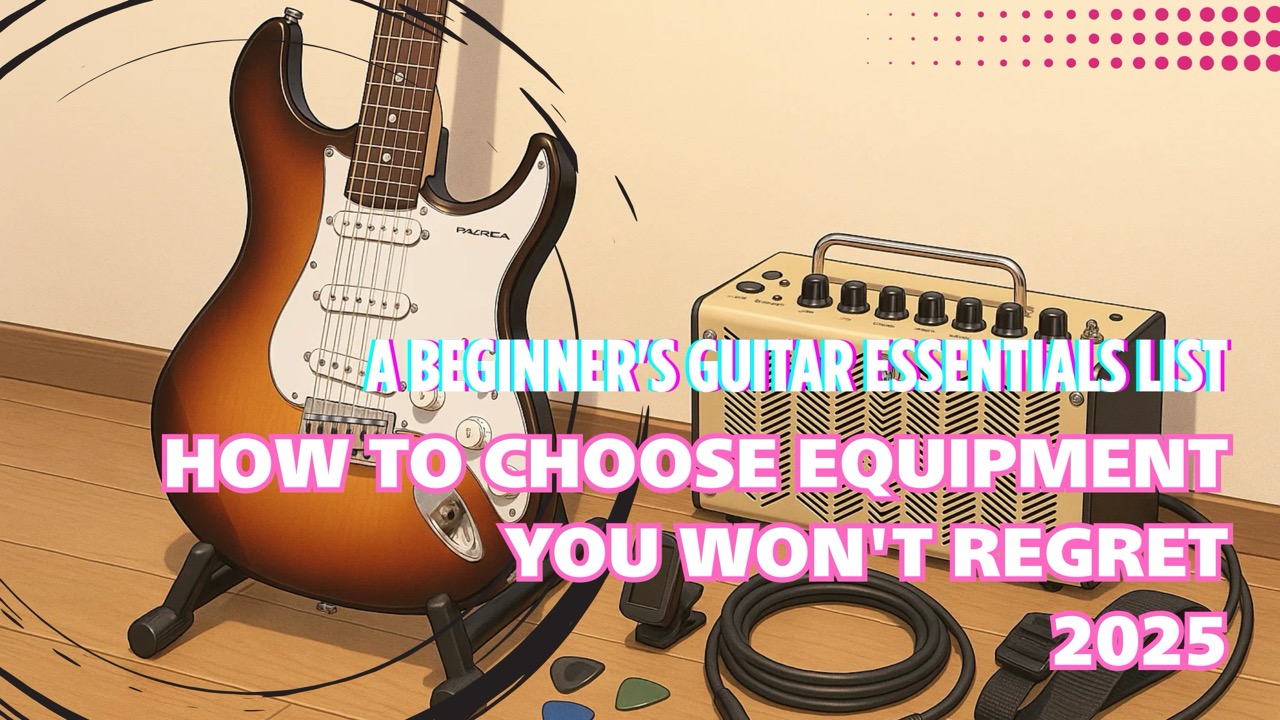


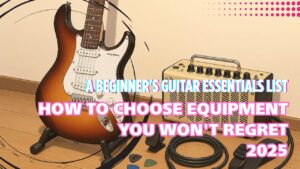
Comments